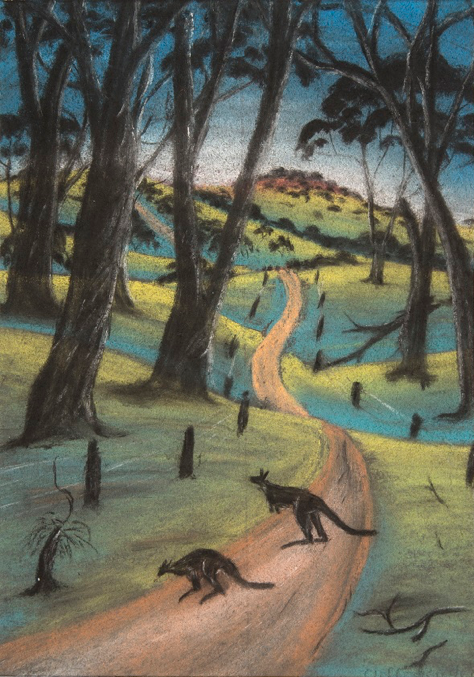On exhibition until June 29 at Lawrence Wilson Art Gallery UWA is Carrolup Revisited: A Journey through the South West of Western Australia – a must-see exhibition for everyone. This collection of exceptional artworks was produced by Noongar children, aged between seven to fourteen, at Carrolup Native Settlement, a mission in the southwest of Western Australia. The art created by these young artistic prodigies in the 1940s and 1950s, with their silhouette landscapes and atmospheric perspectives shot to prominence and toured the world – well before the X-ray art of Western Arnhem Land in the 1950s and 1960s, and the acrylic dot paintings of the Papunya artists in the 1970s and 1980s was recognised by the canon of the Western artworld. Cliff Ryder (above image) is one of the artists who belong to the Carrolup School and who, with others, continued to paint throughout his life. The artworks that are currently on exhibition are not only important for their stylistic qualities, but their depiction of memories of traditional Noongar customs that would otherwise be lost to history. Presenting them in this show is an important contribution to culture, that of both the Noongar people and the larger artistic community.
The history of Carrolup is one that should be acknowledged. First opening in 1915, Carrolup Native Settlement was a government run institution that housed Aboriginal and part-Aboriginal children as a means of controlling and assimilating the Noongar population. The children living at the settlement, recognised now as the Stolen Generations, were forcibly taken from their families and parents were refused visitation rights. Understandably, the removal of children from their families caused widespread displacement and a breakdown of Aboriginal family structures. Inhumane conditions and budget constraints forced the closure of the Settlement in 1922; in 1939 it was reopened for a further 12 years. (Croft and Gooding 2003, Rosser 2018) It was during these 12 years that the children living at the Settlement, without formal artistic training, began creating uniquely beautiful artworks. Their paintings depict from memory detailed landscapes of flora and fauna that incorporate kangaroos, possums, and birdlife, animated Noongar people participating in corroborees and hunting, totemic symbols, roads and fence lines, and the stylistic incorporation of atmospheric perspective.
These young artistic prodigies had their debut onto the international arena in 1948, with a selection of works sent to New Delhi at a UNESCO sponsored educational seminar (Stanton 1992). From here, an agent transported the children’s artworks to Australia’s eastern states and Tasmania, to New Zealand, Britain, America, and the Netherlands for exhibition, sending money made from art sales back to the Settlement. As a result of their early international recognition affording the collection to be exhibited in the United Kingdom in 1956, these artworks were the first stand-alone exhibition of Aboriginal art overseas. Thus, the histories of display the works have accrued adds layers of significance to the current exhibition at LWAG. One of these such significances is that the recognition of the Carrolup artists in Perth is incredibly valuable to the local Noongar community, as the art is a reminder of their artistic and cultural heritage. The existence and preservation of these works reads as more significant when compared with the widespread erasure of indigenous culture that was intended by the very conditions that the works were created in. The conservation and ongoing exhibitions of these early images continues to influence, inspire and educate generations of people. The current exhibition at LWAG must be celebrated for its embrace of these principles.
Words by Ainslie Gatt
Masters Candidate UWA, BA (Visual Culture), UnivCertMusmSts
Image credit:
Cliff Ryder, Carrolup, Kangaroos on Road (detail), 1948, pastel on paper, 25 x 18 cm. Donated through the Australian Government’s Cultural Gifts Program by E.S. Phillips and Dr G. Phillips, [1992/0101] © family of the artist
Footnotes:
Croft, Brenda L., and Janda Gooding. 2003. South West Central: Indigenous Art From South Western Australia 1833-2002. Perth, Western Australia: Art Gallery of Western Australia.
Rosser, Debra. 2018. “Marribank – Organisation – Find & Connect – Western Australia.” [Document]. Commonwealth of Australia, Last Modified 2018-11-20. https://www.findandconnect.gov.au/ref/wa/biogs/WE00136b.htm#related.
Stanton, John. 1992. Nyungar Landscapes: Aboriginal Artists of the South-West: The Heritage of Carrolup, Western Australia, Occasional paper; no. 3. Nedlands, WA: University of Western Australia, Berndt Museum of Anthropology.

